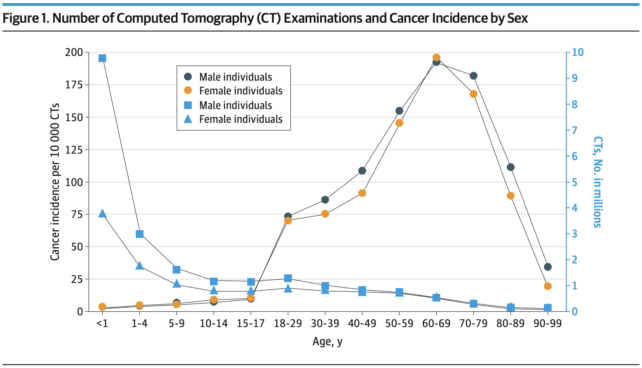Doctors Know Best...
"Approximately 103,000 radiation-induced cancers were projected to result from these [CT scans] examinations.""These findings suggest that if current radiation dosing and utilization practices continue, CT-associated cancers could eventually account for five percent of all new cancer diagnoses annually.""Part of the reason that there's so much overuse is that the potential harm of medical imaging and of CT scanning in particular is not considered or assessed. There's an optimistic view of medial imagining, that it provides useful information at no cost of harm to the patient.""And that's not true. Everything we do in health care comes with potential risk. CT scanning, just like everything else, has potential risks and potential benefits.""Sometimes CT scanning is the right test to provide the most accurate or rapid information. And in those settings patients should get the CT. But in many situations there are alternatives, and I encourage patients to have these conversations with their health care providers."Dr. Rebecca Smith-Bindman, professor of epidemiology and biostatistics, University of California, San Francisco.
 |
| CT and MRI scanners look similar, but they use different parts of the electromagnetic spectrum to take images. Image: Alain Jocard/AFP |
A large-scale study of CT scans performed in the United States estimates the technology has the potential to lead to over 100,000 cancer cases in patients. Projected Lifetime Cancer Risks From Current Computed Tomography Imaging was published in the Journal of the American Medical Association (JAMA), reflecting a study undertaken by Dr. Smith-Bindman. Her studies demonstrated that 61.5 million Americans in 2023 underwent 93 million CT scans -- of whose total 53 percent were female, slightly exceeding their male counterparts.
Ionizing radiation of the type used in standard X-rays are used in CT scans, in significantly steeper doses. While a chest X-ray delivers roughly the same amount of radiation as normally received from the environment in a ten-day period, a CT scan can deliver hundreds of times more radiation, equivalent to a two-year accumulation of background radiation. Yet CT scans are in wide use, often without regard to the real necessity of their use, when other, less potentially questionable methods of detection can substitute.
The types of cancer that can develop over time attributable to the exposure of high radiation levels from the use and repeated use of CT scans include lung cancer, colon cancer, leukemia and bladder cancer. For female patients stricken with cancer whose cause can be traced to the use of CT scans, breast cancer appeared the second most common type of cancer to emerge.

What pertains to fallout from the ungoverned and casual use of CT scans in the United States, refers as well to patient outcomes in Canada from the use of this medical technology. It is the ubiquity of the CT scans that has led to a proliferation of medical aftereffects. The U.S. numbers can be adjusted to apply to Canadian patients in the use of CT scans for the very same reason. About 6.4 million CT scans were performed in Canada in 2022, which would logically work out to 7,200 new cancer cases over these patients' lifetimes.
Dr. Smith-Bindman's study noted that a group, Choosing Wisely, asked medical organizations which tests were being made use of more frequently than really needed. "One of the tests that was identified by many medical societies that their members overused was CT scans", she observed. As an example, routine use of CT scans prior to surgery, or to hunt out the presence of blood clots for no purpose when none are suspected. "CT scans are a good way to look for blood clots, but it's way over-utilized."
There are times when alternative imagining can be used. "We know that ultrasound is a really good test for diagnosing kidney stones or children's acute appendicitis and yet CT scanning is often used for the test when ultrasound would be just as good or better", pointed out Dr. Smith-Bindman. In addition to which radiation dosage can be modified to ensure certain thresholds are not exceeded. The doctor made reference to an organization called Know Your Dose which focuses on various types of medical dosages.
"We can absolutely try to reduce all those excessive doses. We need buy-in from physicians and hospitals.""We need patients to ask their doctors, 'Can you use low dose when you scan me?'""It's crazy that patients have to ask for it, but it's actually really successful.""There's nothing you can do about radiation that you've been exposed to already. But you want to limit future exposure to cases when you really need it."Dr. Rebecca Smith-Bindman
 |
| CT scans use ionizing radiation to create cross-sectional images of the body, providing more detail than X-rays. kckate16/iStockphoto/Getty Images |
Labels: Canada, Cancer Risk, CT Scans, Patient Outcomes, Radiation Dosage, United States

0 Comments:
Post a Comment
<< Home